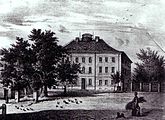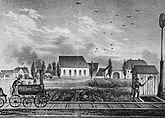Paunsdorf
|
Paunsdorf district of Leipzig |
|
|---|---|
| Coordinates | 51 ° 20 '54 " N , 12 ° 27' 8" E |
| surface | 3.68 km² |
| Residents | 14,368 (Dec. 31, 2018) |
| Population density | 3904 inhabitants / km² |
| Incorporation | 1922 |
| Postcodes | 04328, 04329 |
| prefix | 0341 |
| Borough | east |
| Transport links | |
| railroad | RB 110, RB113 |
| tram | 7, 8 |
| bus | 72, 73, 79, 90, N7 |
| Source: statistik.leipzig.de ; LVB route plan | |
Paunsdorf is a district in the eastern district of Leipzig . Today Paunsdorf consists of two parts: Old Paunsdorf and the new construction area Neu-Paunsdorf, which was built in 1987. The neighboring districts are Heiterblick in the north , Engelsdorf in the south-east, Mölkau in the south, Sellerhausen - Stünz in the south - west and Schönefeld -Est in the north-west .
history
The history of the place, first mentioned in 1335 as Bunsdorf, is closely linked to the development of the manor , which from 1410 belonged to the feudal lord Pflugk and subsequently - with a break from 1621 to 1645 - to the Thümmel family. The Schönefeld estate also fell to her. In 1783 the nave of the village church, which still exists today (since 1946 " Genezarethkirche ") with an early classical interior on the field stone plinth of the previous building, was built by Johann Carl Friedrich Dauthe . The neo-Gothic tower with a pointed helmet was added in 1875.
The village suffered badly from the Battle of Nations in October 1813. After initially Saxon parts of the Napoleonic troops barricaded themselves in the village, Paunsdorf was stormed by the allies. They captured 19 guns, and more than 3,000 Saxons changed fronts. Even today, a monument from 1913 near the church commemorates the storming. Of the 66 houses in the village, 33 were completely burned down after the fighting ended, and many others were badly damaged.
Until 1856, Paunsdorf was part of the Electoral Saxon or Royal Saxon District Office in Leipzig . From 1856 the place belonged to the Taucha court office and from 1875 to the Leipzig District Administration .
After 1820, building activity began in Paunsdorf, which increased the population from 552 in 1834 to 805 in 1852. The foothills of industrialization also reached Paunsdorf in the second half of the 19th century: The Johann Gottfried Böttger type foundry was the first industrial company to set up shop in 1863 . In the early years of 1874–1876, the place expanded to the east with the construction of numerous residential buildings. In 1880 there were already 1,604 people living in Paunsdorf. Two years later, on August 18, 1882, the SPD politician Hermann Liebmann was born here.
In 1837, the Leipzig- Althen section of the Leipzig-Dresden Railway , which ran south of the town center, was opened and in 1839 it was extended to Dresden . Since the establishment of the first professional community council in January 1887, the village tried in vain to incorporate it into nearby Leipzig. In the same year Paunsdorf was connected to the Leipzig – Geithain railway line ( Paunsdorf-Stünz stop , from 1905 train station , now stop again), which runs parallel to the Dresden line to Paunsdorf. This resulted in the development of an elongated industrial area along the railway lines. In the following years, with the settlement of further industrial companies (including the brass rolling mill of Hugo Schneider AG from 1898/1899 (renamed HASAG in 1934)) , Paunsdorf increasingly assumed the character of an industrial suburb. When the neo-baroque town hall was inaugurated by Fritz Drechsler on Schwedenstraße at the corner of Rathausstraße (today Theodor-Heuss-Straße and Am Röschenhof) in April 1912 , the town had 5,000 inhabitants. The incorporation to Leipzig finally took place - with the exception of the areas belonging to the manor - in 1922. At that time Paunsdorf had 5,700 inhabitants.
In 1897 and 1898, the first marathons were run on German soil in Paunsdorf . The 40 km long route ran from the Neues Gasthof in Paunsdorf to Bennewitz and back.
From 1966 to 1969, some young people from Paunsdorf broadcast a self-made program of local news and forbidden Western music on its frequency during the break in broadcasting the soldier's station , which they named after the station Freie Berlin Sender Freies Paunsdorf .
Official seats
From September 7, 2011, the seat of the Veterinary and Food Inspection Office of the City of Leipzig will be in the Paunsdorf Town Hall, which was previously unused for years.
education
The city of Leipzig maintains six schools in Paunsdorf : the Paunsdorf Oberschule , the 24th ( elementary school ) at Paunsdorfer Gutspark, the Brothers Grimm School (elementary school) as well as the Theodor-Körner-School (elementary school) and the Thomas Müntzer School (middle school) and the Gustav-Hertz-Schule Leipzig (grammar school).
Transport links
An individual traffic connection to the city and the surrounding area is given for Alt-Paunsdorf via Riesaer Strasse (old B6) and Theodor-Heuss-Strasse, with Riesaer Strasse from around Ostheimstrasse (Leipzig- Stünz ) in its extension as Leipziger Strasse and B 6 to Kühren b. Wurzen runs parallel to the first German long-distance railway Leipzig – Dresden for over 30 kilometers. For Neu-Paunsdorf there is a connection via Permoserstraße (B 6) and Heiterblickallee. With the exception of the four streets listed above, all Paunsdorf streets are speed 30 zones.
In the area of public transport , tram lines 7 and 8 connect Paunsdorf with the city center and Sommerfeld . Both lines drive on Riesaer Straße to the Paunsdorf tram station and then turn onto a separate track. From there, both lines are run separately from individual traffic to their respective terminals. During the day, both lines complement each other at 4/6 minute intervals. On Saturdays there is a 7/8 minute cycle during the day. On Sundays, line 7 operates at 30-minute intervals early in the morning and late in the evening, with every 15 minutes in between.
The terminus of line 8 Paunsdorf-Nord was in Paunsdorf when it opened, but according to the current city map it is now in Heiterblick.
On weekdays and Saturdays the bus line 90 connects Paunsdorf with the Paunsdorf-Center (PC) and Wahren, on Sundays it only runs to the Paunsdorf tram station. Bus line 72 runs on weekdays and Saturdays from Paunsdorf (bus turning point) via Engelsdorf and Mölkau to the main train station, where it meets tram lines 7 and 8 again.
In the evening, line 73 ends at the Paunsdorf bus stop.
The 79 bus runs every 20 minutes from Thekla via Paunsdorf to the Connewitz S-Bahn station, creating an important north-south connection. In the summer months every second trip is extended to the Cospudener See .
During the night, the N7 night bus connects the city center with Paunsdorf. This runs from the main train station on weekdays at 1.11 a.m., 2.22 p.m., 3.33 a.m., on weekends and public holidays additional buses run at 1.45 a.m. and 3.00 a.m.
New Paunsdorf
The urban planning for Neu-Paunsdorf was in the hands of Leipzig architects and engineers under the direction of the architects Horst Siegel , Georg Eichhorn and Angelika Vámos - based on a competition design from the Berlin Building Academy (Achim Felz) that won first prize . With 6,290 residential units , Neu-Paunsdorf is one of the last large housing estates of the industrial prefabricated building of the GDR and the second largest in Leipzig after Grünau (→ prefabricated buildings in Leipzig ). In the 1990s, more modern and better equipped apartment blocks were added on a smaller scale and some single-family houses were built. In addition, the Paunsdorf Center was built as the largest shopping center in Leipzig and the second largest in Germany (as of 2011) .
The Neu-Paunsdorf blocks have been successively renovated and modernized since 1997/98.
Personalities
- Gottfried Wilhelm Küstner (1689–1762), Privy War and Appeal Council, Mayor of Leipzig
- Hermann Ampach (1829–1903), manor owner and member of the Reichstag
- Hermann Liebmann (1882–1935), editor of the Leipziger Volkszeitung, politician and victim of National Socialism
- Rudolf Jahn (1906–1990), resistance fighter against National Socialism, GDR politician and diplomat
- Rolf Krickow (1921–2003), radio presenter and editor
literature
- Cornelius Gurlitt : Paunsdorf. In: Descriptive representation of the older architectural and art monuments of the Kingdom of Saxony. 16. Issue: Amtshauptmannschaft Leipzig (Leipzig Land) . CC Meinhold, Dresden 1894, p. 94.
Web links
- Paunsdorf in the Digital Historical Directory of Saxony
- Information website My district of the city of Leipzig for Paunsdorf
- Files and plans for the Paunsdorf-Stünz stop in the holdings of the Reichsbahndirektion Halle in the State Archives Saxony-Anhalt, Dessau department
Individual evidence
- ^ Karlheinz Blaschke , Uwe Ulrich Jäschke : Kursächsischer Ämteratlas. Leipzig 2009, ISBN 978-3-937386-14-0 ; P. 60 f.
- ↑ The Amtshauptmannschaft Leipzig in the municipal register 1900
- ^ Frank Gottert: Marathon Mecca Leipzig. 30 years of the Leipzig Marathon. 1977 to 2006. Looking back on 30 years of the Leipzig Marathon. Actors, runs, conditions and statistics. Leipzig Marathon e. V., Leipzig 2007, ISBN 978-3-00-021486-8 , p. 6 ff. ( PDF ( Memento of March 27, 2015 in the Internet Archive ); 14.9 MB)
- ↑ Contemporary witness Karl-Heinz Krause in the series Back then in the GDR (Part 3: Utopia behind walls ) of the MDR







